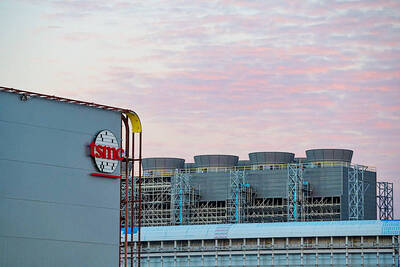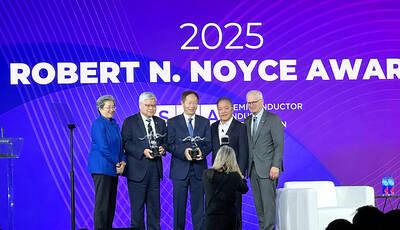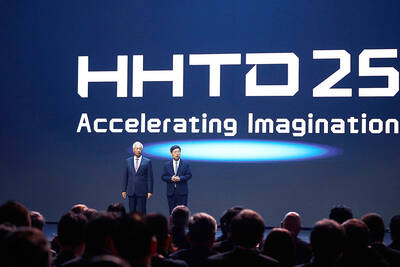A group of local and foreign contractors yesterday urged the government to consider building “intelligent bridges” when reconstructing structures destroyed by Typhoon Morakot in southern Taiwan.
London-based Arup Group Ltd, which is known for its design of the Sidney Myer Music Bowl in Melbourne and the “Bird’s Nest” in Beijing, said yesterday it was willing to share its architectural expertise and take part in the reconstruction of Shuangyuan Bridge (雙園大橋), which connects Kaohsiung and Pingtung counties, as a modern cable-stayed bridge pre-installed with a monitoring system.
HIGH-TECH
“Such a high-tech bridge, pre-installed with a global positioning system [GPS], will signal an alert to ensure the safety of bridge users,” Arup vice chairman Andrew Chan (陳嘉正) told a media briefing yesterday.
Based on data collected by the GPS and weather conditions, such as forecast rain and wind velocity, the bridge’s administrator can monitor and decide when to close the bridge, he said.
The monitoring system can also provide a health reading of the bridge during routine maintenance, he said.
Chan, however, yesterday said it was premature to estimate the cost of building such a bridge.
Tseng Ching-tsung (曾景琮), vice president of RSEA Engineering Corp (榮民工程公司), said the government should not hold separate bids for the design and construction of the bridge because it creates problems for contractors who may have to contend with an “infeasible design.”
SINGLE BID
Instead, the government should combine the two into a single bid open to design-and-construction teams to accelerate and ensure efficient construction, he said.
Chiu Fu-sheng (邱復生), chairman of Taiwan Land Development Corp (台開), which is a local partner of Arup, yesterday expressed interest in working as a coordinator for the bridge project.
However, he said it was too early to say whether all three companies would jointly bid for the project.
He also said the companies’ proposed bridge could be a model for the rebuilding of 70 bridges that collapsed in the wake of the typhoon.

Shiina Ito has had fewer Chinese customers at her Tokyo jewelry shop since Beijing issued a travel warning in the wake of a diplomatic spat, but she said she was not concerned. A souring of Tokyo-Beijing relations this month, following remarks by Japanese Prime Minister Sanae Takaichi about Taiwan, has fueled concerns about the impact on the ritzy boutiques, noodle joints and hotels where holidaymakers spend their cash. However, businesses in Tokyo largely shrugged off any anxiety. “Since there are fewer Chinese customers, it’s become a bit easier for Japanese shoppers to visit, so our sales haven’t really dropped,” Ito

The number of Taiwanese working in the US rose to a record high of 137,000 last year, driven largely by Taiwan Semiconductor Manufacturing Co’s (TSMC, 台積電) rapid overseas expansion, according to government data released yesterday. A total of 666,000 Taiwanese nationals were employed abroad last year, an increase of 45,000 from 2023 and the highest level since the COVID-19 pandemic, data from the Directorate-General of Budget, Accounting and Statistics (DGBAS) showed. Overseas employment had steadily increased between 2009 and 2019, peaking at 739,000, before plunging to 319,000 in 2021 amid US-China trade tensions, global supply chain shifts, reshoring by Taiwanese companies and

Taiwan Semiconductor Manufacturing Co (TSMC) Chairman C.C. Wei (魏哲家) and the company’s former chairman, Mark Liu (劉德音), both received the Robert N. Noyce Award -- the semiconductor industry’s highest honor -- in San Jose, California, on Thursday (local time). Speaking at the award event, Liu, who retired last year, expressed gratitude to his wife, his dissertation advisor at the University of California, Berkeley, his supervisors at AT&T Bell Laboratories -- where he worked on optical fiber communication systems before joining TSMC, TSMC partners, and industry colleagues. Liu said that working alongside TSMC

TECHNOLOGY DAY: The Taiwanese firm is also setting up a joint venture with Alphabet Inc on robots and plans to establish a firm in Japan to produce Model A EVs Manufacturing giant Hon Hai Precision Industry Co (鴻海精密) yesterday announced a collaboration with ChatGPT developer OpenAI to build next-generation artificial intelligence (AI) infrastructure and strengthen its local supply chain in the US to accelerate the deployment of advanced AI systems. Building such an infrastructure in the US is crucial for strengthening local supply chains and supporting the US in maintaining its leading position in the AI domain, Hon Hai said in a statement. Through the collaboration, OpenAI would share its insights into emerging hardware needs in the AI industry with Hon Hai to support the company’s design and development work, as well